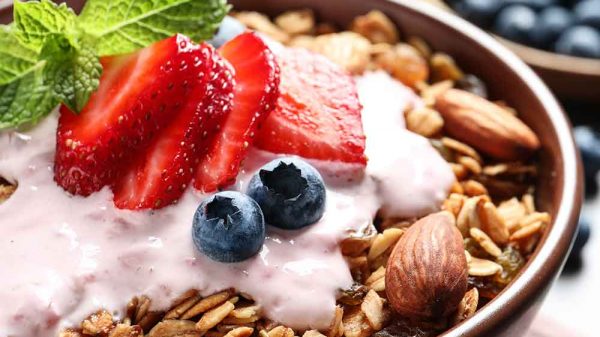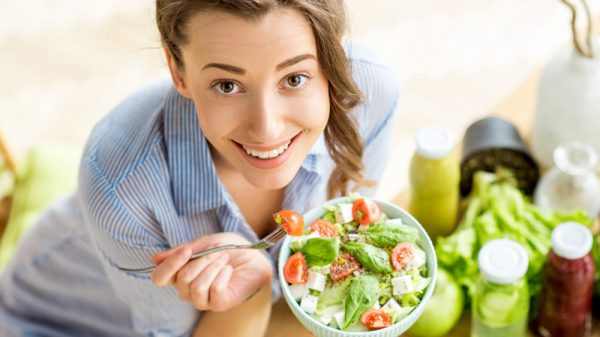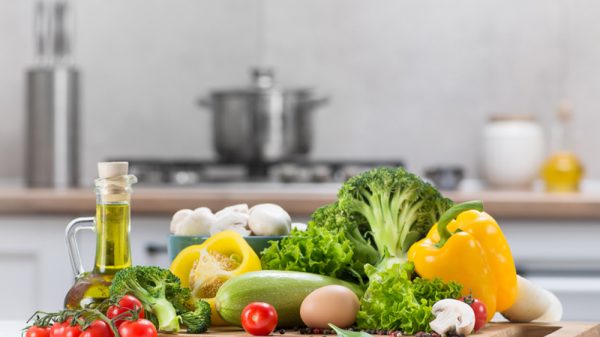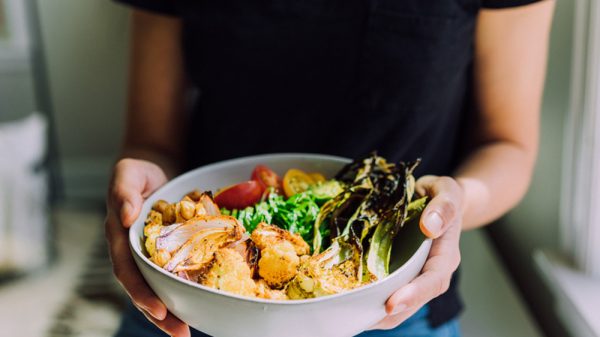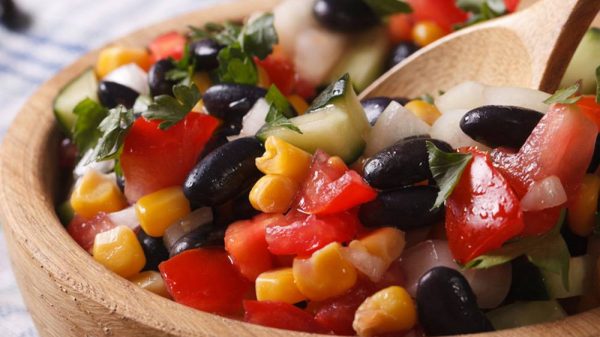Are you vegetarian and concerned about getting enough protein? Protein is a vital macronutrient that supports all-around health and wellbeing. Healthy muscle growth and neurotransmitter production are just two examples of the many roles that protein plays in the body. This is why it’s so important to get protein in your diet on a daily basis through high protein vegetarian meals.
You may know that meat is a major source of protein in the omnivore’s diet. But is it possible to get enough protein on a vegetarian diet? Absolutely. In fact, getting enough protein is not as difficult as you might think, once you know what foods to eat. To make it easier for you, we’ve compiled strategies for getting enough protein on a vegetarian diet, including recipes for high protein vegetarian meals. Read on to find out more!
What It Means to Follow a Vegetarian Diet
Following a vegetarian diet means avoiding eating any part of the animal’s body. This means leaving out meats and meat-based foods like chicken, steak, fish, lamb, pork, bacon, pepperoni, meat sauce, organ meats, and other products. However, most vegetarian diets include products like milk, cheese, yogurt, and eggs.
It’s important to make a distinction between the vegetarian and vegan diet. While a vegetarian diet allows the consumption of animal milk and eggs, the vegan diet avoids the consumption of all animal-based products.
Why Is Protein So Important?
Getting an abundance of protein in your diet is vital for your health. Protein is made of tiny compounds called amino acids, which are often described as the building blocks of protein. Amino acids are the components of protein that the body uses to manufacture muscle tissue, connective tissue, neurotransmitters, hormones, and enzymes. Amino acids are generally categorized as either nonessential or essential. While the body can produce nonessential amino acids to be used in biological mechanisms, essential amino acids must be obtained from the foods we eat.
Without balanced ratios of essential amino acids, the body cannot function optimally. Getting all of the essential amino acids the body needs is crucial for strengthening the immune system, improving recovery after working out, and helping the body cope with conditions like fatty liver disease, hormone imbalance, and metabolic disorders.
So, beyond simply eating high-protein foods, these foods must also offer ideal ratios of essential amino acids. The tips we provide below are geared towards ensuring that you are getting the essential amino acids you need on a daily basis.
Quick Guide to Protein on a Vegetarian Diet
Knowing what proteins pair nicely and how to get your protein on a vegetarian diet allows you to create your own protein-packed vegetarian meals.
Dairy and Eggs
Dairy and eggs are typically the only animal-based products that are consumed on a vegetarian diet. They are also the only complete protein sources on the vegetarian diet. This means that they provide balanced ratios of essential amino acids that the body needs on a daily basis.
Whole Grains
Whole grains are packed with fiber, minerals, and protein. Examples of whole grains include whole-wheat bread, whole grain pasta, brown rice, rolled oats, and quinoa. Whole grains are grains that are unprocessed or minimally processed. This means that the grain retains its outer hull, which is the part of the plant with the highest concentration of protein, fiber, and nutrients.
Refined grains like white bread, white rice, and white pasta have all been exposed to an industrial process that removes this nutrient-rich hull, leaving the starchy interior behind. These refined products spike your blood sugar and over time can cause issues with insulin function and fatty liver disease.
Beans
Beans are a great source of vegetarian protein as well as fiber, vitamins, and minerals. Vary the beans in your diet to keep the flavors interesting. Beans we love include kidney beans, black beans, chickpeas, cannellini beans, and black-eyed peas.
Nuts and Seeds
Nuts and seeds provide protein while also affording healthy polyunsaturated and monounsaturated fats. Sprinkling pumpkin seeds and sunflower seeds on oatmeal, cereal, and salads and an easy and crunchy way to get a little extra protein. Nuts like cashews, almonds, walnuts, and peanuts work great in trail mix. Pistachios are a delicious snack on their own. In particular, walnuts, flaxseeds, chia seeds, and pecans are packed with healthy polyunsaturated fats called omega-3 fatty acids, which are known to help reduce inflammation and fight against metabolic conditions like insulin resistance, type 2 diabetes, and fatty liver disease.
Soy Protein
Soy protein is the one vegetable protein that almost supplies a full profile of essential amino acids. Soy protein can be found in soybeans and edamame, as well as soybean products like tofu, and tempeh.
Other Protein Products
The food industry offers many vegetable-based protein products that are intended to replace meat in certain meals. For example, many grocery stores offer premade vegetarian nuggets, sausage, and burgers. Many of these products will be made primarily out of soy protein. Some products contain seitan, which is a protein-rich food made of wheat gluten. Though it is a healthy food, it’s best to avoid it if you have an allergy or sensitivity to gluten. It’s a good idea to check the food labels before purchasing a premade product and make sure there are no added sugars, saturated fat, preservatives, and coloring.
Pairing Your Proteins
Dairy and eggs are the only complete proteins that can be eaten on the vegetarian diet. This means that they afford optimal ratios of essential amino acids. Though there are other great plant-based protein sources to incorporate into a vegetarian diet, it’s important to combine these proteins throughout the day to get all of the essential amino acids that you need. For example, add ground flaxseeds to your oatmeal, add some quinoa and walnuts to your salad, and serve bean dishes over brown rice.
Protein Supplements
Though you don’t need protein supplements at every meal, having protein powders on hand is helpful for when you don’t have time to prep or you require an extra punch of protein. Whey protein and casein are included in many different protein powders and offer a complete and balanced profile of essential amino acids. When choosing a protein powder, check the ingredients list and nutrition facts for harmful ingredients like added sugars, preservatives, and coloring.
Essential amino acids are another protein supplement that provides essential amino acids that are already broken down into their individual form. This kind of supplement is easier to digest for individuals with digestive and liver issues, and it also provides fewer calories.

High Protein Vegetarian Meals
The first step to making sure your vegetarian diet is also high in protein is to make sure you know what to eat. Once you have some recipes and meal ideas up your sleeve, eating high-protein as a vegetarian doesn’t have to be hard! We go through ideas for breakfast, lunch, dinner, and snacks that you can use to pack your diet with high-quality protein.
Vegetarian Breakfast Ideas
1. Breakfast Sandwich
Sandwiches don’t need to be saved for lunch! Sandwiches make a fast, delicious breakfast. Choosing the right bread and filling is important to make sure your breakfast sandwich is packed with the protein you need to fuel your day.
Traditional Breakfast Sandwich
This breakfast is a spin on the classic bacon, egg, and cheese sandwich. Instead of bacon, choose tofu or a soy-based sausage replacement prepared by sautéing in a pan over medium heat. If you want to find a minimally processed sausage replacement, tofu, tempeh, and seitan are excellent options. For the egg, scramble up some egg whites and season with salt and pepper. Assemble by toasting a whole-grain bagel, and briefly place the bagel in the oven with a slice of cheese to melt the cheese. Stick to low-fat versions of cheese, like mozzarella and cheddar. Top the bagel with the egg and soy-based protein.
In this hearty breakfast, cheese and eggs provide optimal ratios of essential amino acids. Soy protein provides essential amino acids as well, though not in complete optimal ratios. For a punch of antioxidants, top with sliced tomatoes and sautéed spinach. Enjoy with ketchup, hot sauce, or seasoning of your choice. You can also prepare this sandwich ahead of time, wrap in foil, then pop into the oven to reheat.
Oatmeal
Synonymous with “boring,” oatmeal has a bad reputation for being a pretty lame breakfast. However, it doesn’t have to be boring at all, and it can be pumped up with protein for a fantastic vegetarian breakfast option. First, cook your favorite oats in the microwave or on the stovetop. Add in ground flaxseeds, ground chia seeds, and cinnamon, and stir until well mixed. Next, choose your favorite protein powder to mix into your oatmeal. Low-sugar whey protein powder or essential amino acid powder is a great option. For extra flavor and antioxidants, add your favorite frozen fruit, like blueberries or raspberries. Stir the berries into the oatmeal until they are partially melted. Top with chopped dates, sliced bananas, and a drizzle of agave nectar.
Protein Pancakes
Usually viewed as a decadent treat, pancakes can be transformed into a nourishing, protein-packed breakfast. To do this, simply trade out refined flour for whole grain flour, which contains more fiber and protein. Then add a scoop or two of vanilla protein powder to the batter, depending on how many servings you are making. Protein pancakes can also be stored in the refrigerator or the freezer for a quick and easy breakfast that’s also packed with nutrients. Enjoy with your favorite toppings, like sliced bananas and a drizzle of grade A maple syrup.
Greek Yogurt Parfait
This breakfast protein-packed version of your favorite decadent breakfast parfait. For the yogurt, use low-sugar, nonfat Greek yogurt, which is very high in protein that affords optimal ratios of essential amino acids. Layer with puffed rice cereal, crushed walnuts, and blueberries. If you need an extra kick of sweetness, drizzle with honey.
2. Vegetarian Lunch Ideas
Pasta Salad
When you think of pasta salad, you might be thinking of creamy, goopy sauce and pasta with bacon bits. However, pasta salad doesn’t have to be unhealthy and can be packed with the protein you need to power your body. Start by preparing a batch of whole-grain pasta, buckwheat pasta, lentil pasta, and chickpea pasta. All of these options are excellent alternatives to using regular white pasta, as they are filled with fiber and protein.
Lentil and chickpea pasta tend to contain the most protein. For example, a serving of Essential amino acids lentil pasta contains a whopping 25 grams of protein! Lightly coat your favorite vegetables in olive oil, salt, pepper, and garlic powder, and roast in the oven until thoroughly cooked. Onions, peppers, tomatoes, and eggplant are delicious choices that also afford tons of fiber, vitamins, and minerals. Allow the vegetables to cool, and then toss with pasta in a plant-based pesto sauce. For extra protein, stir in a can of chickpeas and chunks of low-fat cheddar cheese. For a pop of flavor, add chopped sundried tomatoes.
Panini Sandwiches
A warm panini sandwich is a filling and comforting lunch that is also quite versatile. To make a balanced panini sandwich that’s also filled with protein, start out with two slices of whole-grain bread. The bread with the highest protein usually contains nuts and seeds. Top with a couple slices of low-fat mozzarella cheese, wilted greens, roasted red pepper, a few chunks of avocado and a thin slice of tofu marinated in liquid smoke. Season with black pepper, salt, and a dash of cayenne pepper for a little heat. Press in the panini, and you’ve got yourself a decadent – but still healthy – grilled cheese. As with the breakfast sandwich described above
Pita Sandwich
A homemade pita pocket is a perfect vehicle to help you fit a lot of protein into your vegetarian lunch. First, spread hummus onto a whole grain pita bread and add a few falafel pieces. Both hummus and falafel provide protein. Then, prepare a small salad of chopped romaine lettuce, parsley, tomatoes, onions, crushed almonds, and cucumber. Top your salad with a drizzle of olive oil, lemon juice, salt, and pepper. Stuff your pita bread with the salad, and top with a bit of tzatziki sauce.
Greek Salad
For a vegetarian lunch option that’s a bit lower in carbs, go for a salad with the works. Start with chopped greens of your choice, such as kale, spinach, and arugula. Top with sliced onions, banana peppers, roasted red pepper, and Kalamata olives. Greens and vegetables on their own are not filling and provide no protein, so make sure to include plenty of toppings. If you’re looking for primarily plant-based, dairy-free options, make sure to include grains, nuts, and beans to ensure that you’re getting balanced ratios of essential amino acids. For example, add a scoop of brown rice, white beans, and crushed walnuts to your salad. If you want to use dairy, add chunks of low-fat feta cheese to your salad. Top with your favorite low-fat, low-sugar Greek salad dressing.
3. Vegetarian Dinner Ideas
If you’re a vegetarian, it may be challenging sometimes to figure out what food to eat for dinner that provides vitamins and minerals as well as plenty of protein. We’ve come up with a few ideas to help you feel satisfied with your vegetarian dinner.
Homemade Pizza
We know what you’re thinking. Pizza? Healthy and high in protein? Goes against everything that we normally think, pizza can actually be rather healthy when prepared from scratch. Preparing pizza dough at home can be one way to ensure that your pizza crust is packed with fiber, protein, and other micronutrients. Preparing your pizza dough with alternative flours like wholemeal flour and buckwheat flour is an excellent way to ensure that your pizza crust is healthy. If you’re looking for a lower-carb option, you can prepare a pizza crust using cauliflower, flaxseed, and just a little bit of almond meal.
After preparing the crust, it is vital to choose healthy toppings that afford plenty of vitamins, minerals, fiber, and protein. Choose a tomato sauce that is low in sugar. When topping your pizza with cheese, make sure to use a blend of cheese that is low in saturated fat. All cheeses even when low on fat maintain high levels of protein that provide balanced ratios of essential amino acids.
Now, it’s time to add the toppings of your choice. Add an abundance of vegetables like spinach, green peppers, onions, garlic, fresh-cut tomatoes, broccoli, and basil, which provide lots of fiber, vitamins, and minerals. For extra protein add slices of soy-based “sausage” or slices of tofu cooked in olive oil, garlic, salt, and pepper. Cook in the oven and enjoy.
Pasta with Marinara Sauce
Pasta and marinara sauce may seem like a very simple meal. However, it’s extremely versatile and you can pack a lot of veggies and protein into marinara sauce. Plus, this is one of the easiest and fastest dinners to make when you’re strapped for time and just have to use whatever you find in the pantry and your refrigerator. First, chop your vegetables and saute in a pan with a little olive oil. Use whatever vegetables you have on hand, such as onions, garlic, peppers, tomato, spinach, kale, broccoli, eggplant, zucchini, etc.
When the vegetables begin to soften, add one block of tofu and a can of chickpeas to the pan. Use a wooden spoon or spatula to break up the tofu as it cooks. Season the tofu and vegetable medley with garlic powder, onion powder, dried oregano, dried basil, and red pepper flakes for an extra kick.
When the vegetables and tofu are cooked, or an entire jar of your favorite pasta sauce into the pan until well mixed. If you want to add an extra dimension and extra protein to your pasta dish, you can find high-protein vegetarian “meatballs” that are made with tofu and tempeh. Serve over your favorite high protein pasta and enjoy.
Tofu and Lentil Chili
Together, tofu and lentils provide an abundance of protein, and texturally combine to make a delicious chili. First, sauté onions, garlic, and green bell pepper in a pan with a drizzle of olive oil. Add a block of firm tofu, and mash until it reaches the consistency of ground meat. Add a can of tomato paste as well as spices like chili powder, cumin, paprika, cayenne pepper, salt, and black pepper. To complete the chili, add cooked brown lentils, black beans, kidney beans, crushed tomatoes, and vegetable broth. Allow to simmer until the flavors meld together. Serve with crushed corn chips, low-fat cheese, and avocado slices.
Nuggets and Fries
Nuggets and fries make a classic dinner that satisfies even the pickiest of eaters. Normally, nuggets are made of meat and other animal parts, and if you are vegetarian, this is not on the menu for any meal. Luckily, you can find many nugget alternatives in the grocery store that are made of high-quality ingredients like soy protein. Many of these nuggets can be prepared by baking them in the oven. Serve with homemade sweet potato fries. Prepare the fries by slicing a sweet potato into strips, tossing them with a drizzle of olive oil, and bake until browned and soft. Make sure to keep the skin on when you prepare the sweet potato fries since sweet potato skin is filled with extra vitamins, minerals, and fiber. To add some extra protein and vegetables to this meal, prepare brown rice and sautéed broccoli for a well-balanced meal. Serve with low sugar ketchup for dipping. keep in mind that even though vegetarian nuggets are far healthier than chicken nuggets, they are still classified as processed food. In general, it’s best to stick to unprocessed foods whenever possible. However, having vegetarian nuggets on hand no one you need to whip up dinner quickly is helpful for keeping you on track.
Cajun Beans and Rice
Beans and rice might sound like a simple dish, but it can provide balanced ratios of essential amino acids as well as fiber, vitamins, and minerals. Prepare brown rice, black beans, and kidney beans. Mix together and season with Cajun seasoning like Tony Chachere’s creole seasoning. To dress up your beans and rice dish, add chopped and sautéed red peppers, carrots, onions, celery, and garlic. Serve with a dash of hot sauce and enjoy.
Tacos
Tacos are a highly versatile dish that can serve as a vehicle for protein as well as vegetables. To create a vegetarian version of tacos simply combine all the ingredients that you want to add to your taco. For example, maybe you want to include onions, garlic, sweet potato, kidney beans, black beans, kale, corn, zucchini, and tofu.
Season with prepared taco seasoning or create your own taco seasoning by combining spices such as garlic powder, chili powder, cumin, paprika, cayenne pepper, salt, and pepper. Layer whole grain tortilla wraps with brown rice and a generous helping of filling. Top with salsa, hot sauce, chopped cilantro, avocado, and a squeeze of lime.
Veggie Burger
You can prepare veggie burgers ahead of time, made of black beans and quinoa. These burgers store well in the refrigerator or freezer and can be easily reheated for a quick and protein-packed weeknight meal. Top with low-fat cheddar cheese, tomato, and lettuce. Serve with a whole-grain bun or bread with ketchup and mustard or salsa and guacamole.
Veggie and Tempeh Stir Fry
A quick stir fry is one of the fastest meals you can prepare on the fly, which also contains lots of protein. First, slice tempeh or tofu into pieces and lightly cook in olive oil and curry powder. Throw sliced veggies in the pan. You can use whatever you have in your pantry and refrigerator such as onions, snow peas, green beans, cauliflower, broccoli, and red peppers.
Saute with the tempeh until cooked and add extra curry powder and salt and pepper. Add coconut milk, ginger paste, garlic, and lemongrass to create a sauce. Allow your stir fry to simmer until the sauce has reduced a little bit and the vegetables reach a desirable texture. Enjoy over brown rice.
4. Vegetarian Snack Ideas
Shakes and Smoothies
Shakes and smoothies provide a fast and easy way to get energy and protein, and you can make different flavored shakes depending on what you’re craving. For example, if you want a thick chocolate shake, combine frozen bananas, soy milk, and chocolate whey protein powder. If you’re craving a smoothie that is more like a refreshing juice, combine spinach, fresh orange juice, frozen strawberries, soymilk, and essential amino acid powder.
Protein Bars
Protein bars are a great go-to snack when you’re in a pinch. Make sure to choose a protein bar that is low in added sugars, low in saturated fat, and lists ingredients that are pronounceable. Aim to reserve protein bars for when you’re strapped for time and options, simply because protein bars are still processed products that may contain ingredients like preservatives and coloring. Sticking to whole foods is usually the best option.
Trail Mix
A classic snack, trail mix is known to fuel up even the most intense hikers and athletes. Variety is key to making the most healthy and tasty trail mix. For example, combine walnuts, almonds, dried edamame, dried cranberries, and dark chocolate chips.
Homemade Protein Bites
These are easy snacks that can be stored in the freezer and take on the go whenever you need them. To prepare protein bites, combine pitted dates, walnuts, and protein powder in a blender. Because blending the powder with the dates may be difficult, you may want to first try adding a little almond milk to the protein powder to create a paste.
Now, blend the paste with the pitted dates and walnuts. For an extra punch of flavor, add miniature dark chocolate chips. Shape into balls and freeze. Whenever you need an extra punch of protein, grab a protein ball or two from the freezer for a tasty and nutritious snack.
Meal Prepping Is Key
Meal prepping is a key to making sure you consistently get the nutrients and protein you require in your diet. Plus, vegetarian meal prep tends to be a lot easier than meat-based meal prep, since you don’t need to spend time and energy preparing and cooking the meat.
One of the most central parts of vegetarian meal prepping is slicing the vegetables ahead of time. Because let’s face it, how many of us enjoy a busy day at work or taking care of the kids, only to start laboriously slicing vegetables at dinnertime? Having onions, red peppers, green peppers, and yellow peppers cut into strips can be used for stir-fries and salads. Having carrot, celery, and onion pre-diced in the refrigerator creates a base for soups and stews. It’s also helpful to have bags of pre-washed, ready-to-eat spinach and kale on hand that can easily be dumped into your dish.
Prepping fruit is also really helpful to make it easy to prepare smoothies. You can freeze berries yourself or buy bags of your favorite frozen fruits like blueberries, raspberries, blackberries, and cherries. Allow bananas to ripen, peel and cut into slices, and freeze in a large bag. Frozen bananas give smoothies a punch of natural sweetness while also creating a creamy texture.
Having garlic and ginger already pre-ground is crucial for flavoring your dish in a pinch. Simply blend or dice garlic and place in an airtight container, and blend or chop ginger and place in an airtight container. You can also purchase pre-chopped ginger and garlic, though the fresh version affords a more robust flavor.
Beyond fruit and vegetable prep, you can also prepare meals ahead of time to make it easy to just grab and go. For example, preparing pasta salad, veggie burgers, bagel breakfast sandwiches on a Sunday will make your life so much easier during the week when you need something to eat.
Seasoning Enhances Flavor
Anything can taste good if you have the right seasoning! Always having sauces and spices on hand is key for making sure that you can make your vegetarian meals tasty. Here are a few ideas for seasonings and sauces that should always be in your refrigerator or pantry.
- Pesto: You can prepare your own pesto using arugula, basil, cashews, salt, pepper, and a drizzle of olive oil. Store-bought pesto is also totally fine, just purchase the dairy-free version. Regular pesto tends to be packed with saturated fat from parmesan cheese.
- Tomato sauce: Having your favorite marinara sauce on hand is an easy way to disguise vegetables and prepare a pasta dish.
- Taco seasoning: Having taco seasoning on hand is a fast and easy way to add a kick of flavor to tacos, burritos, chili, or stir-fry.
- Salsa: Since there are so many kinds of salsa, you can have a variety available in your pantry to spice up a dish when needed. For example, you can use green salsa or chipotle salsa, mild or hot!
- Hot sauce: Similar to salsa, hot sauce is also available in a variety of flavors and can spice up any dish, from a burrito to a pasta dish.
- Curry powder: Having a good curry powder available makes it easier to prepare curried bean dishes and stir-fries.
- Italian seasoning: Italian seasoning usually contains a blend of dried herbs like basil, parsley, and oregano. Italian seasoning can help pump up the flavor in all dishes from pasta to salad.
- Salad dressing: Salad dressings are key to help make salads easier to eat. Having a few salad dressings in the refrigerator helps provide variety. For example, a balsamic vinaigrette, Greek dressing, Italian dressing, and avocado-based green dressing are a tasty sampling. Always check the labels before buying salad dressings to make sure they don’t contain saturated fat and added sugar. In general, it’s best to steer clear of cream-based dressings.
Tips for Making Cheap Vegetarian Meals
A pro to eating vegetarian is that a lot of times, it is much cheaper than the traditional meat-based diet! The cheapest kind of vegetarian meal relies primarily on whole foods, keeping processed foods at a minimum. Foods like vegan nuggets and other meat substitutes tend to be substantially more expensive than whole foods. Here are a few tips for following a protein-rich vegetarian diet that’s also budget-friendly.
- Buy things in bulk: High-protein, vegetarian foods can be bought cheaply in bulk. For example, dried beans, quinoa, brown rice, nuts, and oats are excellent high-protein foods that can be bought in large quantities.
- Go to a farmer’s market: Prices at the farmer’s market tend to be low since all of the produce is local. If you have a farmer’s market nearby, make a habit of going once a week or so to stock up on the locally grown and seasonal produce.
- Meal prep: Prepping your meals ahead of time is useful for more than just convenience. Meal prepping also lowers the probability of extras being thrown out. Plus, the more you food prep, the more you’ll get the hang of how much food This means that food lasts longer, saving you money.
- Avoid eating out: This one goes for everyone, regardless of whether you’re following a vegetarian diet or not. Eating out and ordering food might be tasty and easy, but it is hard on your wallet. Preparing food at home is a much cheaper option that will save you a lot of money in the long run.
High Protein Vegetarian Meals: Conclusion
Meatless meals don’t need to be devoid of protein. High protein meals can be completely vegetarian while also offering all of the nutrients you need. Focus on making sure you supply your body with balanced ratios of essential amino acids that allow for optimal health. Having a few vegetarian recipes up your sleeve can help you regularly eat meals that are rich in protein. Dairy and eggs provide optimal ratios of essential amino acids. Soy protein, beans, nuts, seeds, and whole grains must be combined throughout the day in order to obtain all essential amino acids.
